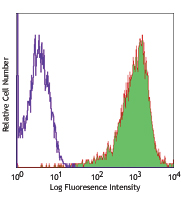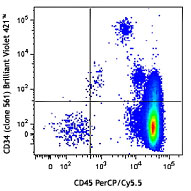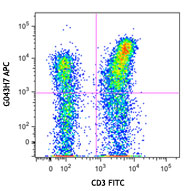- Clone
- RCR-401 (See other available formats)
- Regulatory Status
- RUO
- Other Names
- Endothelial protein C receptor, protein C receptor, PROCR, activated protein C receptor, APC receptor
- Isotype
- Rat IgG1, κ
- Ave. Rating
- Submit a Review
- Product Citations
- publications

-

HUVEC cells were stained with CD201 (clone RCR-401) PE (filled histogram) or rat IgG1, κ PE isotype control (open histogram).
| Cat # | Size | Price | Quantity Check Availability | Save | ||
|---|---|---|---|---|---|---|
| 351903 | 25 tests | 94€ | ||||
| 351904 | 100 tests | 254€ | ||||
Endothelial protein C receptor (EPCR), also known as CD201, is a 46 kD N-glycosylated type I transmembrane protein primarily expressed on the endothelial cells of arteries and veins in heart and lung. It is also expressed at high levels on a subset of hematopoietic stem cells and a subset of dendritic cells. CD201 functions as a primary receptor for protein C activation, which results in inhibition of both intrinsic and extrinsic coagulation pathways. It also plays an important role in many pathophysiologic processes, such as inflammation responses to infection, trauma, hematopoiesis, and autoimmune response. Deletion of the CD201 gene in knock-out mice leads to embryonic lethality before embryonic day 10, indicating that CD201 expression is critical for embryo development. In humans, mutations of CD201 have been associated with venous thromboembolism and myocardial infarction as well as with late fetal loss during pregnancy.
Product DetailsProduct Details
- Reactivity
- Human
- Antibody Type
- Monoclonal
- Host Species
- Rat
- Formulation
- Phosphate-buffered solution, pH 7.2, containing 0.09% sodium azide and BSA (origin USA)
- Preparation
- The antibody was purified by affinity chromatography and conjugated with PE under optimal conditions.
- Concentration
- Lot-specific (to obtain lot-specific concentration and expiration, please enter the lot number in our Certificate of Analysis online tool.)
- Storage & Handling
- The antibody solution should be stored undiluted between 2°C and 8°C, and protected from prolonged exposure to light. Do not freeze.
- Application
-
FC - Quality tested
- Recommended Usage
-
Each lot of this antibody is quality control tested by immunofluorescent staining with flow cytometric analysis. For flow cytometric staining, the suggested use of this reagent is 5 µl per million cells in 100 µl staining volume or 5 µl per 100 µl of whole blood.
- Excitation Laser
-
Blue Laser (488 nm)
Green Laser (532 nm)/Yellow-Green Laser (561 nm)
- Product Citations
- RRID
-
AB_10897801 (BioLegend Cat. No. 351903)
AB_10900806 (BioLegend Cat. No. 351904)
Antigen Details
- Structure
- 46 kD of N-glycosylated type I transmembrane protein
- Distribution
-
Endothelial cells, subset of hematopoietic stem cells, subset of dendritic cells
- Function
- Inhibits blood coagulation, inflammation, and hematopoiesis
- Interaction
- Activated receptor1 (Par-1)
- Ligand/Receptor
- Protease C
- Cell Type
- Dendritic cells, Endothelial cells, Hematopoietic stem and progenitors
- Biology Area
- Apoptosis/Tumor Suppressors/Cell Death, Cell Biology, Costimulatory Molecules, Immunology
- Molecular Family
- CD Molecules
- Antigen References
-
1. Kerschen E, et al. 2010. J. Clin. Invest. 120:3167.
2. Iwasaki H, et al. 2010. Blood 116:544.
3. Balazs AB, et al. 2006. Blood 107:2317. - Gene ID
- 10544 View all products for this Gene ID
- UniProt
- View information about CD201 on UniProt.org
Related Pages & Pathways
Pages
Related FAQs
- What type of PE do you use in your conjugates?
- We use R-PE in our conjugates.
Customers Also Purchased


Compare Data Across All Formats
This data display is provided for general comparisons between formats.
Your actual data may vary due to variations in samples, target cells, instruments and their settings, staining conditions, and other factors.
If you need assistance with selecting the best format contact our expert technical support team.
 Login / Register
Login / Register 















Follow Us